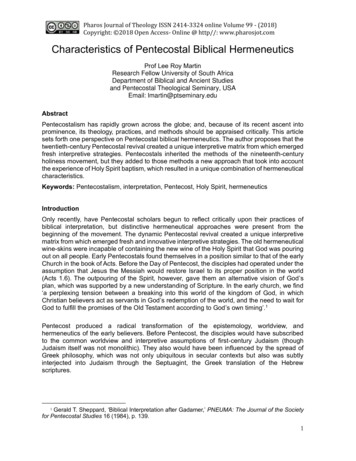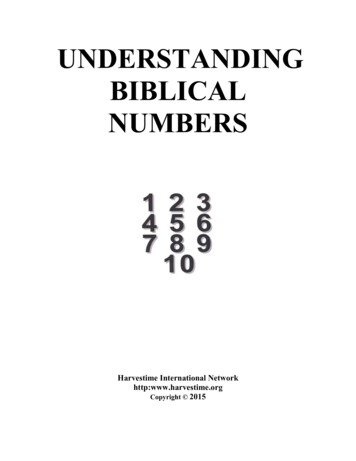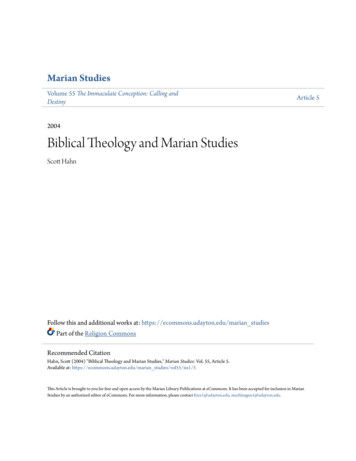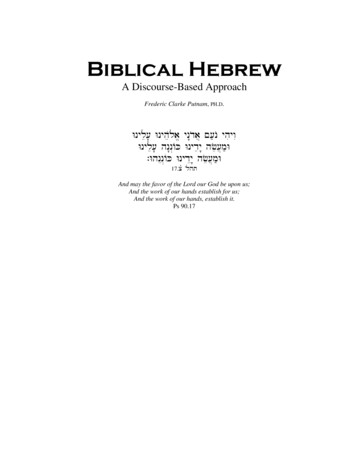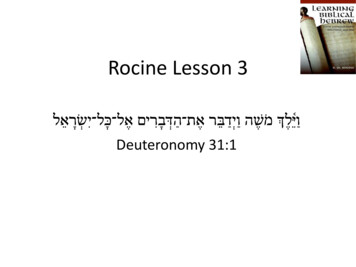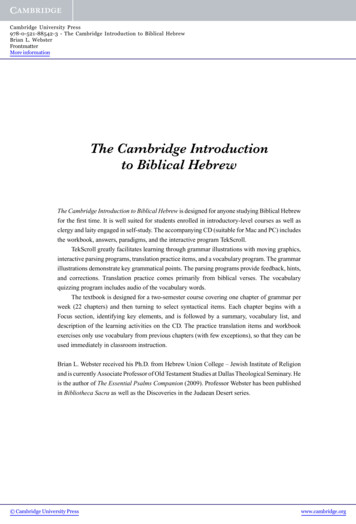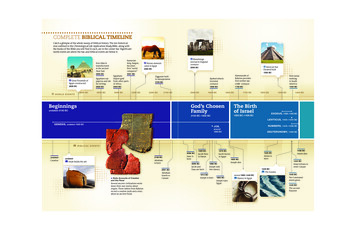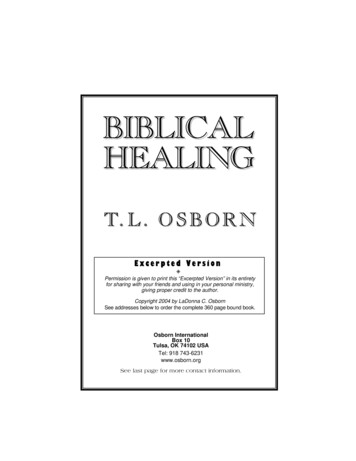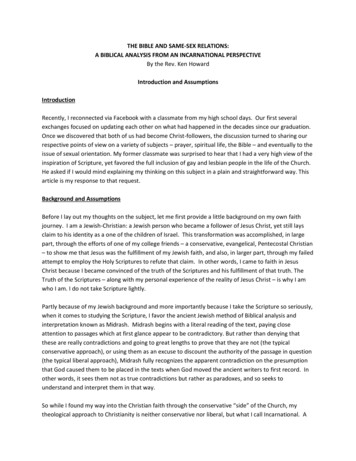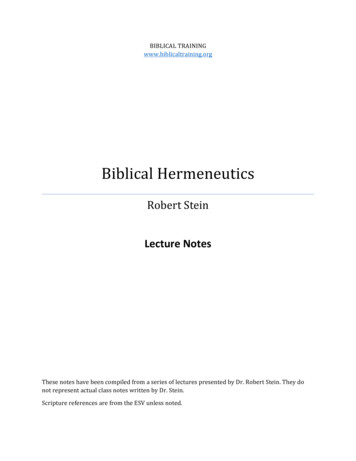
Transcription
BIBLICAL TRAININGwww.biblicaltraining.orgBiblical HermeneuticsRobert SteinLecture NotesThese notes have been compiled from a series of lectures presented by Dr. Robert Stein. They donot represent actual class notes written by Dr. Stein.Scripture references are from the ESV unless noted.
Biblical HermeneuticsRobert SteinContents1. Introduction to the Class . 2. Early Beginnings to the Present . 3. Hermeneutical Issues Involved in Translation .4. Various Involved with Translation .5. An Introduction to Hermeneutics- Part 1 6. An Introduction to Hermeneutics- Part 2 7. A Vocabulary for Interpretation- Part 1 8. A Vocabulary for Interpretation- Part 2 9. A Vocabulary for Interpretation- Part 3 10. The Role of the Holy Spirit .11. The Miraculous in Scripture . 12. G. B. Caird, The Language and Imagery of the Bible .13. Proverbs . . . 14. The Genre and Language of Prophecy 15. Further Examples of Prophecy .16. Prophecy and the Beginning Discussion of Mark 17. Prose and Poetry, and Examples from the Old Testament .18. Types of Poetry in the Bible . .19. Idioms . . 20. The Genre of Exaggeration- Part 1 . 21. The Genre of Exaggeration- Part 2 .22. Introduction to Parables 23. Interpretation of Parables . .24. Allegory and Historical Narrative .25. Clues to Interpreting Historical Narrative . 26. Understanding the Letters in the New Testament .27. How Sentences Are Understood .28. The Genre of Covenant . .29. Psalms . 30. The Books That Make Up the Bible 6566-7071-7576-7879-8182-8586-9091-9394-992
Biblical HermeneuticsRobert Stein1. Introduction to the ClassI.Overview of the CourseII.Recommended Reading Introduction to Biblical Interpretation, Revised Edition by Williams W. Klein, CraigL. Blomberg, and Robert L. Hubbard, Jr.III. Basic Guide to Interpreting the Bible: Playing by the Rules by Robert H. Stein Journey from Texts to Translations: The Origin and Development of the Bible byPaul D. WegnerGoal of the Course Introduce students to an overview of the history of the English Bible Introduce students to a conceptual framework for Bible interpretation Master a vocabulary for biblical interpretive studies Discussion of the various genres found in the Bible and their respective rules ofinterpretation3
Biblical HermeneuticsRobert Stein2. Early Beginnings to the PresentI.Early Beginnings to the Presenta. The Making of the English Languagei. Anglo-Saxon dialectThe Anglo-Saxon dialect began in the 5th century as an amalgamation oflanguages. Sometimes referred to as Old English, it became the commondialect of England.ii. French influenceIn the 11th century, William the Conqueror from France conqueredEngland and thus brought a French influence which eventually becamethe English language.b. Early TranslationsThe Latin Vulgate was the bible of the early church but most people in Englandcouldn’t read or write. Bible stories were learned through art; e.g. paintings,stained glass windows, traveling troubadours who told stories through songs.i. John WycliffeJohn Wycliffe translated the 1st bible into the English language from theLatin Vulgate in 1382. He was a pre-Luther/Calvin reformer. Thistranslation occurred before the printing press and was thus handwritten.This translation led to criticism of the clergy as people began to read theBible for the first time and recognize discrepancies in the character andpractices of the religious leaders. In response, there was a “clampingdown” on the use of translations in the common language. By 1414, itbecame a capital offense to be caught reading the Bible in the Englishlanguage.ii. William TyndaleIn 1526, William Tyndale published the 1st Bible in English to betranslated from Greek and Hebrew texts. It was printed in Germany dueto opposition from Henry VIII in England. This was an excellent translationthat served as a basis for most English translations that followed4
Biblical HermeneuticsRobert Steinincluding the KJV. Tyndale was a Luther supporter and adopted Luther’srevised order of NT books.Tyndale was kidnapped by followers of King Henry VIII and was burned atthe stake outside of Brussels in 1536.iii. Miles CoverdaleCloverdale was a disciple of Tyndale who printed the 1st Bible in theEnglish language in completion. He was the 1st person to separate theApocrypha from the rest of the OT. Previously, these books wereintermingled with the OT books of the original Hebrew. The CloverdaleBible was also the 1st Bible to use versification. Previous translationsdivided books by chapters, but not by verses.iv. Thomas Matthew (John Rogers)John Rogers was another follower of Tyndale who published theMatthew Bible in 1537. He was also martyred after his true identity wasdetermined.v. Richard TavernerThe Taverner’s Bible was published in 1539 with King Henry VIII’sapproval. This was largely a revision to the Matthew Bible.King Henry VIII became supportive of the reformers due to his desire fordivorce. By the time of his death, in 1545, England had become apredominately protestant society.vi. The Great BiblePublished in 1539, this Bible was named due to its size. It was the 1stauthorized Bible (authorized by Henry VIII). This Bible sought to be morepalatable to the Roman Catholic clergy by reverting back to thetraditional ordering of the NT books.vii. The Geneva BiblePublished in Geneva, this bible was very Calvinist (as evidenced in thesubstantial marginal notes) and was the popular translation during thereign of Queen Elizabeth.5
Biblical HermeneuticsRobert Steinviii. The Bishop's BibleThe Bishop’s Bible was authorized by the Church of England andpublished in 1568. It was the result of a rejection of the Geneva Bible bythe Bishops in England.ix. The King James VersionIn 1604, King James I ordered a new official translation withoutfootnotes; to be assembled by England’s top scholars. The KJV waspublished in 1611 and became one of the greatest translations in theEnglish language, superseding all previous translations. Interesting note:almost 90% of this translation had Tyndale roots.x. The Douay-Rheims VersionThis version was a direct result of the Council of Trent. In an effort tosatisfy English speaking Roman Catholics, it was derived from the LatinVulgate rather than the original Hebrew/Greek texts. According to theCouncil of Trent, the Latin Vulgate was deemed to be the final authority.This is no longer the position of Roman Catholic scholars.c. Modern VersionsOver the years, the number of new translations have increased dramatically.Existing translations are constantly being revised with minor updates, usuallyresulting in gradual and less dramatic changes.6
Biblical HermeneuticsRobert Stein3. Hermeneutical Issues Involved in TranslationII.Hermeneutical Issues Involved in Translationa. There is no one to one correspondence between languages.According to C.H. Dodd, the 1st axiom of translation: There is no such thing as anexact word equivalent when going from one language to another.Different languages as well as different cultures pose problems for translators.E.g. in Mat 1:18 Mary is said to be betrothed to Joseph. Later in verse 24, Mary isreferred to as his wife. In that culture, an engagement was legally binding andrequired a divorce to break. Our culture has an entirely different understandingof an engagement.b. A good translation should:i. be based on the best manuscripts.Generally speaking, manuscripts dating closer to the original writing arepreferred simply with respect to the likelihood of copy errors. Tyndale,and later translators for the Geneva and King James Bible, used a GreekNew Testament published by Erasmus of Rotterdam in the 16th century.Erasmus used the best Greek manuscripts available at the time.Subsequently, thousands of Greek NT manuscripts, dating centuriesearlier, have been discovered. Thus, modern translations have theadvantage of using these.ii. be based on the latest knowledge of language and culture.E.g. biblical poetry wasn’t recognized or understood until the 17thcentury.iii. be accurate.Liberties taken by translators can lead to inaccuracies. There are alsoexamples where translations were carefully made but errors wereintroduced inadvertently in the printing.iv. be understandable.Some translations can be accurate in their formal equivalence of words,but the resulting sentences can be difficult to understand.7
Biblical HermeneuticsRobert Steinv. be contemporary.Language/ word meanings tend to evolve over time. This is especiallytrue in modern times where word meanings can change over a relativelyshort time frame. This will result in the need of new or revisedtranslations on a more frequent basis.vi. be universal.Some translations have targeted specific groups. This becomesproblematic and lead to misinterpretations when other groups areexposed to it. Translation committees should be diversified to helpminimize this issue.vii. be dignified.A translation should be accurate but avoid being unnecessarily harsh orcrude.viii. avoid a theological bias.This is hard to do but, nevertheless, should be a goal in translation. Sometranslations are blatantly biased. E.g. The New World Translation is theofficial Bible for the Jehovah Witnesses. This translation goes to greatlengths to rewrite or avoid references to the Deity of Christ.8
Biblical HermeneuticsRobert Stein4. Various Issues Involved with TranslationIII.Various Issues Involved with Translationa. Need for new translationsNo translation can ever be the final one, due to the evolving nature of language.Changes in word meaning occur even more frequently today than ever before.b. What does it mean to be "without error?"Inerrancy pertains to what the original authors meant by their words. Atranslation is error-free to the extent that the translators faithfully reproducedwhat the original authors intended.c. Translation Philosophyi. Word-for-wordA word-for-word translation seeks to find the nearest English equivalent,on a word by word basis. The Tyndale Great Bible, the KJV, the RSV, andthe NAS would all be considered word-for-word translations.ii. Thought-for-thoughtIn a thought-for-thought translation, the goal is to reproduce what theauthor was expressing rather than merely finding the closest wordequivalent. Examples of thought-for-thought translations include the NIVand the Revised English Bible.d. Translation PreferenceThought-for-thought translations are preferable for reading through largerportions of Scripture, simply based on readability and understanding. However,for more detailed study (e.g. literary analysis and comparisons of the Gospels) aword-for word version is required.e. Comparison of RSV and NRSVThe NRSV has done a good job re-phrasing verses that are no longercontemporary or simply structured poorly.E.g.: Zec. 3:3“Now Joshua was standing before the angel, clothed with filthy garments.” (RSV)9
Biblical HermeneuticsRobert Stein“Now Joshua was dressed with filthy clothes as he stood before the angel.”(NRSV)“Thou” and “thines” were changed to “you” and “yours” in the NRSV.However, the NRSV has perhaps gone too far in its effort to avoid sexistlanguage. Luke’s Gospel intentionally places male and female examples side byside in stories and parables. This effect has been lost in the NRSV.f. Individual vs. Committee TranslationsCommittee translations are more reliable just by the fact that a group can resistthe preferences or mistakes of one individual.g. The use of footnotesCaution should be taken concerning footnotes, particularly in a study bible. Toomuch credence can be given to a comment simply because “it’s in my Bible”. It isgood to remember that it is Scripture that is infallible and not someone’s opinionon the meaning that happens to be included as a note at the bottom of the page.h. Comparison of Galatians 3:23-29A careful comparison of this passage between the KJV, the NRSV, the NASB, theNIV, The REB, and the Living Bible; will reveal some theological differences.While none of these are severe enough to lead to heresy, the differences exist,nonetheless.10
Biblical HermeneuticsRobert Stein5. An Introduction to Hermeneutics- Part 1I.An Introduction to Hermeneutics (part 1)a. Origin of the word "hermeneutics"Hermeneutics is a transliteration of a Greek verb, hermeneu, which means “tointerpret”.b. Three Components Involved in Communicationi. The author (encoder)ii. A text (code)iii. A reader (decoder)c. What determines meaning?Three theories:i. The text gives meaning.1. Semantic autonomyIn this viewpoint, the text itself is autonomous. The text hasmeaning apart from the author’s intentions. In fact, the author istotally irrelevant.2. ProblemThe problem with this view is it fails to acknowledge that texts areinanimate objects. The abilities to think and reason are necessaryto give meaning. Paper and ink certainly don’t have that capacity.It is inaccurate to say, “The text means this”, because the textitself can’t mean anything.ii. The reader gives the meaning.1. Dominant view of todayThe more current view today is to say that the reader is thedeterminer of meaning. This is not to say that the reader11
Biblical HermeneuticsRobert Steindeciphers or discovers the meaning; the reader actually givesmeaning. With this viewpoint, it follows that there can be multiplemeanings for the same text. The text functions much like aninkblot, with each person seeing something different.2. ProblemIf the Bible really has all these meanings, it really doesn’t meananything.iii. The author gives the meaningThe traditional approach to hermeneutics is to recognize that it is theoriginal author who is the determiner of meaning. If there is a debate onmeaning in one of Paul’s letters, and Paul walked in the room; the debatewould be settled. If you were trying to determine what Paul meant in aparticular passage in Romans, you might look at what he has said on thesame subject in Galatians. This is the common sense approach. The Bibleshould not be treated as some autonomous piece of art but rather, aform of communication.1. Bible translationIn evaluating a translation, you should not consider how muchyou like the language of the text; rather you should ask howaccurately the translators reflect the intended meaning of theauthor.2. LawA current debate today involves the Constitution. Should theJustices be free to determine meaning (reader approach) orshould their jobs be restricted to interpreting what the originalFounders of the Constitution meant by their words.3. ArtThe same debate has occurred with art, e.g. in the restoration ofMichelangelo’s paintings in the Sistine Chapel4. Music5. Literature12
Biblical HermeneuticsRobert SteinWhether art, music, law, or literature; the impetus on making thereceptor the determiner of meaning is really a rebellion againstthe authority of the originator.iv. Objections to authorial meaning1. "Intentional fallacy"This expression was coined by William K. Winsatt, Jr. and MonroeBeardsley in 1954.a. Cannot experience the life of the authorThe first objection to authorial meaning is to say we can’tgo back and experience what the author was experiencingwhen he wrote the text. This is true, but we aren’t tryingto relive his inner feelings/emotions. The goal is simply tounderstand what he was seeking to communicate.b. Author may not be competentThis may be hypothetically true but as Christians, webelieve that the biblical authors were inspired. This meansthat God, through His Spirit, enabled them to adequatelyexpress what He intended to communicate through them.2. "Radical Historicism"This recognizes the vast amount of time and culture differencesbetween today and ancient times. This is a real problem thatshould not be minimized. However, there are certain aspects tohumanity which do not change, based on the fact that we have allbeen created in the image of God. This commonality is a criticalasset in interpreting the meaning of ancient writers.13
Biblical HermeneuticsRobert Stein6. An Introduction to Hermeneutics- Part 2I.An Introduction to Hermeneutics (part 2)d. The Roles of the Three Componentsi. Author1. Meaning is history and therefore unchangeable.The author may change his view or even recant what he wrotepreviously. However, the author cannot go back and change hisoriginal intended meaning. This is locked in history.2. The author wills a meaning.The existence of a text means that there was an intentional efforton the part of an author to communicate something.3. Meaning has implications.An author is not going to communicate a principle by listing everyhypothetical situation. We need to ask the question, “What is the‘pattern of meaning’ or principle that is being conveyed?” Theseimplications may extend even to unconscious meanings. E.g. Paulsaid, “Do not get drunk with wine ” Obviously, the implication isnot to take substances into your body that would cause you tolose control of your faculties. This would have implications forbourbon, marijuana, etc.; substances that Paul would not havebeen aware of in his day.Note: The literal meaning of a text is what the author (writer) ofthe text meant by the words. Literal interpretation does not meanwe interpret everything literally because, in many cases, imageryor hyperbole is used that was not intended by the author to betaken literally.ii. Text1. Share-ability of symbolsa. Norms of language – words14
Biblical HermeneuticsRobert SteinNo one seeks to write a book which cannot be understood.Instead they abide by the norms of language, using wordsin accordance to how they will be understood by theintended audience. If a word is used outside the norms oflanguage, a note of explanation should be added. (E.g.John 2: 19-21. John adds a note to explain that Jesus wasreferring to his body when he used the word “temple”.b. Norms of utterance – contextHow words are constructed (rules of grammar) as well ascontext are essential in communicating in a way that willbe understood.2. Subject matterThe subject matter can be studied strictly for information. This is aperfectly legitimate reason for studying a text. However, if yourgoal is to learn about meaning, you have to ask more than “Whatwas written?” You begin to ask, “Why was it written?”iii. Reader1. Must decipher literary formDetermining the literary form is the 1st step because differentforms have different ways of conveying meaning. E.g. a parablewould not be interpreted in the same manner as narrative.2. Ascertain authorial meanings of symbolsThere are symbols, etc. that were used by the original author andunderstood by the original audience but are now foreign to us (23,000 years later). It is important to seek to learn the meaning ofthese symbols in order to arrive at the correct interpretation.3. Seek significanceWe can discover implications but we don’t create them. Theauthor retains control of meaning and thus the implications ofwhat was written. This extends even to the “unconscious”implications.On the other hand, the reader has control over the significance ofwhat was written. Significance is how the reader gives credenceor credibility to what the author said.15
Biblical HermeneuticsRobert Stein7. A Vocabulary for Interpretation- Part 1II.A Vocabulary for Interpretation (part 1)a. MeaningDefinition of meaning:The pattern of meaning the author consciously willed to convey by the words orshareable symbols he/she usedAll three entities are present in this definition. The author wills to communicate.The text is represented by the words/symbols. The reader is present by theshareable nature of the symbols.b. ImplicationsDefinition of implications:Those meanings in a text of which the author was unaware but neverthelesslegitimately fall within the pattern of meaning he/she willed.i. Galatians 5:2Look: I, Paul, say to you that if you accept circumcision, Christ will be of noadvantage to you.Paul was speaking to people who were being persuaded that faith inChrist alone was not sufficient. The Judaizers were convincing them thatthey must also be circumcised in order to be saved. Paul refutes thisspecifically in the conscious meaning of his words.In Martin Luther’s day, the church was selling indulgences in exchange forgrace (the promise of being saved). Paul would have had no knowledge ofindulgences; they didn’t exist in his day. However, if they could beexplained to Paul, he would say that is exactly the sort of thing I wastalking about. The implications of Paul’s pattern of meaning wouldinclude anything that adds a stipulation to being saved by grace throughfaith in Christ alone.ii. Deuteronomy 22:8When you build a new house, you shall make a parapet for your roof, thatyou may not bring the guilt of blood upon your house, if anyone shouldfall from it.16
Biblical HermeneuticsRobert SteinIn biblical times, the roof was a common place to go to experience anevening breeze. Most people today don’t have roofs that are accessible.This doesn’t mean that this passage is irrelevant to the modern readerwith a steep pitched roof. There are all sorts of implications of which thebiblical author may not have been aware but, nevertheless, fall within thepattern of meaning in regards to concern for the safety of others. E.g. afence around a swimming pool should be the responsibility of an ownerfor the protection of children.iii. 1 Corinthians 16:20All the brothers send you greetings. Greet one another with a holy kiss.How a greeting is expressed will vary from culture to culture but thewarmness of the greeting does not.iv. Psalm 150Let Everything Praise the LORD. Praise the LORD!Praise God in his sanctuary; praise him in his mighty heavens!Praise him for his mighty deeds; praise him according to his excellentgreatness!Praise him with trumpet sound; praise him with lute and harp!Praise him with tambourine and dance; praise him with strings and pipe!Praise him with sounding cymbals; praise him with loud clashing cymbals!Let everything that has breath praise the LORD! Praise the LORD!Should worship be limited to only include the instruments specificallylisted by the writer? The implication seems to be praising God with thetotality of what we have available.v. Deuteronomy 6:6-9And these words that I command you today shall be on your heart. Youshall teach them diligently to your children, and shall talk of them whenyou sit in your house, and when you walk by the way, and when you liedown, and when you rise. You shall bind them as a sign on your hand, andthey shall be as frontlets between your eyes. You shall write them on thedoorposts of your house and on your gates.17
Biblical HermeneuticsRobert SteinThe use of phylacteries and mezuzahs may still be present in Jewishtradition but not in Christian tradition. However, the principle here is forGod’s people to keep His word before them.vi. Mark 7:5-7And the Pharisees and the scribes asked him, “Why do your disciples notwalk according to the tradition of the elders, but eat with defiled hands?”And he said to them, “Well did Isaiah prophesy of you hypocrites, as it iswritten, “‘This people honors me with their lips, but their heart is far fromme; in vain do they worship me, teaching as doctrines thecommandments of men.’"This is interesting because Jesus pulls an implication out of the words ofIsaiah and applies it to the Pharisees. These were not the hypocrites thatIsaiah had in mind but it fits his pattern of meaning.vii. Mark 7:20ffAnd he said, “What comes out of a person is what defiles him. For fromwithin, out of the heart of man, come evil thoughts, sexual immorality,theft, murder, adultery, coveting, wickedness, deceit, sensuality, envy,slander, pride, foolishness. All these evil things come from within, andthey defile a person.”This is another example of implications found within the text. If youcompare the parallel passage in Matthew (Mat. 15:10-20), you will seethat some of the sins listed in Mark are omitted in Matthew while othersins are added in Matthew’s version. There is not a problem with thesetwo Evangelists failing to record exactly which sins Jesus specificallymentioned. It would be perfectly acceptable for each of these inspiredwriters to include their own implications based on specific issues thatwere present in their respective audiences.viii. Exodus 21:28ffWhen an ox gores a man or a woman to death, the ox shall be stoned,and its flesh shall not be eaten, but the owner of the ox shall not be liable.But if the ox has been accustomed to gore in the past, and its owner hasbeen warned but has not kept it in, and it kills a man or a woman, the oxshall be stoned, and its owner also shall be put to death. If a ransom is18
Biblical HermeneuticsRobert Steinimposed on him, then he shall give for the redemption of his life whateveris imposed on him.This may not seem relevant, especially in our culture, but whether or notyou have an ox; the passage has implications. An owner’s responsibilityfor an animal in regards to the safety of others is different, depending onwhether or not the animal is known to be dangerous.Note: It is important to remember that the author is in control of theimplications. It is not the text itself but the author who worded the text(and what that author meant) that determines the legitimate implicationsthat flow out of it.ix. Exodus 22x. NarrativeThe stories found in the Bible have implications as well. Care should betaken to determine the main point of the narrative before pulling outimplications. E.g. the story of Jesus calming the storm is about Hissupreme authority and power, even over something as unpredictable anduntamed as the weather. The main point of this story is not about givingnautical facts surrounding the Sea of Galilee.xi. Acts 1:8But you will receive power when the Holy Spirit has come upon you, andyou will be my witnesses in Jerusalem and in all Judea and Samaria, andto the end of the earth.The implications of this commission are that God’s people will witness forHim throughout the world. This has specific implications for each believerin regards to their personal circumstance in life.19
Biblical HermeneuticsRobert Stein8. A Vocabulary for Interpretation- Part 2II.A Vocabulary for Interpretation- Part 2c. SignificanceHow a reader responds to the meaning of a text, an act of the will.While meaning and implications are determined by the author, significance isdetermined by the reader. It pertains to the volitional aspect of how we, asreaders, are to respond to the text.d. Subject matterThe content (or "stuff") talked about in a text.This pertains to the descriptive data/facts found in the text; not necessarilyconcerned with meaning.e. UnderstandingThe correct mental grasp of the author’s meaningIf two people have the correct understanding it would mean they have the sameunderstanding.f. InterpretationThe verbal or written expression of a reader's understanding of the author'smeaning.Understanding between people can be the same but their interpretation can bedifferent. If fact, the same person can express their understanding using adifferent example. Therefore, interpretations may vary even whenunderstanding is consistent/correct. Once an understanding is expressed, itbecomes an interpretation.g. Mental actsThe experiences the author went through when writing the text. (C.S. Lewis,"Fernseed and Elephants")Attempts at reconstructing the experience of an author as he wrote, is seldompossible to do with accuracy, even with a contemporary writer. To think one canaccomplish this with a biblical author that wrote 2000 years ago, in an entirelydifferent culture, is beyond optimistic. Our job as interpreters is not to try andguess what was going through Paul’s mind as he wrote the letter. Our job isunderstand what he meant by what he wrote.20
Biblical HermeneuticsRobert Steinh. Norms of languageThe range of meanings allowed by the words or the verbal symbols of a text.The norms of language permit multiple meanings for the same expression. Adictionary is helpful in determining this range of meaning.i.Norms of utteranceThe specific meaning that the author has given to a word, phrase, sentence andthe like in a text.We are able to move from norms of language to norms of utterance byconsidering context. This is the sentence, paragraph, story; in which the word isused. The most helpful tool to determine specific meaning is a concordance.Here you can find where the author used the same word elsewhere which can bevery helpful in understanding his specific use of the word.j.Literary genreThe literary form used by the author and the rules that govern that form.Determining the form of literature and applying the appropriate rules areessential for correct interpretation.k. ContextThe willed meaning that an author gives to the literary materials surrounding thetext.Context is more than just the words surrounding an expression. Context involvesthe meaning that is being communicated by the author.21
Biblical HermeneuticsRobert Stein9. A Vocabulary for Interpretation- Part 3II.A Vocabulary for Interpretation (part 3)l.Discussion of Klein, Blomberg, and Hubbard on Meaningi. "Our goal remains to hear the message of the Bible as the originalaudiences would [should] have heard it or as the first readers would[should] have understood it." (pg. 11)This is different than the definition of meaning given in this class.However, the reference to “shareable symbols” brings in
The Geneva Bible Published in Geneva, this bible was very Calvinist (as evidenced in the substantial marginal notes) and was the popular translation during the reign of Queen Elizabeth. Biblical Hermeneutics
